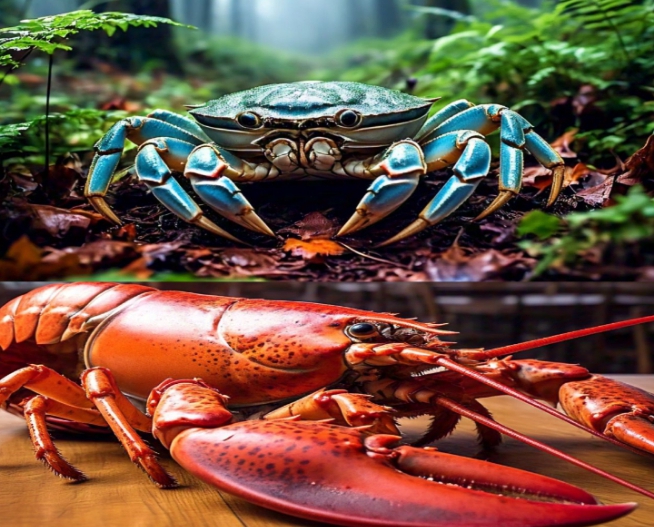Crabs and lobsters are both popular seafood choices, but they belong to different families and have distinct characteristics. Understanding these differences can enhance your culinary experience and help you make informed choices when selecting these crustaceans. Below, we explore the various aspects that differentiate crabs from lobsters, including their biology, habitat, culinary uses, and more.
Biological Classification
| Feature | Crab | Lobster |
|---|---|---|
| Class | Malacostraca | Malacostraca |
| Order | Decapoda | Decapoda |
| Family | Varied (e.g., Portunidae) | Nephropidae |
| Body Shape | Broad and flat | Long and cylindrical |
| Claws | Two claws, often asymmetrical | Two large claws, usually symmetrical |
Body Structure
Crabs typically have a wider, more flattened body compared to lobsters, which have a longer and more cylindrical shape. This difference in body structure affects their movement and habitat preferences. Crabs tend to scuttle sideways due to their joint structure, whereas lobsters swim backward using their tail.
Claws
One of the most recognizable features of crabs is their asymmetrical claws, which can vary in size and shape. The larger claw is often used for defense and competition, while the smaller claw is used for feeding. In contrast, lobsters have two large, symmetrical claws which are primarily used for capturing prey and defending against predators.
Habitat
| Feature | Crab | Lobster |
|---|---|---|
| Habitat | Coastal areas, estuaries | Ocean floor, rocky crevices |
| Depth Range | Intertidal to deep sea | Typically shallow waters, up to 600 feet |
| Behavior | Often social, can form groups | Generally solitary |
Living Environment
Crabs are commonly found in coastal areas, estuaries, and even freshwater environments. They can thrive in both salt and freshwater, making them more adaptable to various habitats. Lobsters, on the other hand, prefer to dwell on the ocean floor, often seeking refuge in rocky crevices or burrows. Their preference for deeper waters limits their exposure to shifting environmental conditions.
Culinary Uses
| Feature | Crab | Lobster |
|---|---|---|
| Flavor | Sweet, delicate | Rich, buttery |
| Preparation Methods | Boiling, steaming, grilling | Boiling, steaming, baking |
| Popular Dishes | Crab cakes, crab legs | Lobster bisque, lobster rolls |
Taste and Texture
The flavor profiles of crabs and lobsters are notably different. Crab meat is often described as sweet and delicate, making it ideal for dishes like crab cakes or salads. Lobster meat, in contrast, is richer and has a buttery texture, which lends itself well to more luxurious dishes like lobster bisque or simply boiled with butter.
Cooking Techniques
Both crabs and lobsters can be prepared using various cooking methods, including boiling, steaming, and grilling. However, lobsters require more careful handling due to their size and cooking time. The meat of a lobster is often considered a delicacy, leading to more gourmet preparations.
Nutritional Value
| Nutritional Aspect | Crab | Lobster |
|---|---|---|
| Calories | Lower (approximately 83 per 3 oz) | Higher (approximately 145 per 3 oz) |
| Protein | High (approx. 17g per 3 oz) | High (approx. 27g per 3 oz) |
| Fat | Lower (1g per 3 oz) | Higher (approximately 2g per 3 oz) |
Health Benefits
Both crabs and lobsters are excellent sources of protein and contain essential vitamins and minerals. Crab meat is lower in calories and fat, making it a healthy option for those watching their intake. Lobster, while slightly higher in calories and fat, offers a rich source of omega-3 fatty acids and other nutrients.
Conclusion
In summary, crabs and lobsters, while both delicious seafood options, have significant differences in their biological classification, habitat, culinary uses, and nutritional value. Understanding these differences can help you appreciate each crustacean’s unique qualities and enhance your dining experience. Whether you prefer the sweet, delicate flavor of crab or the rich, buttery taste of lobster, both offer delightful culinary adventures in their own right.















